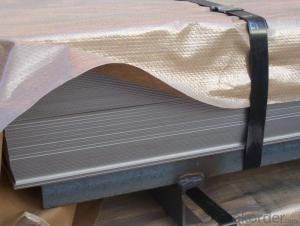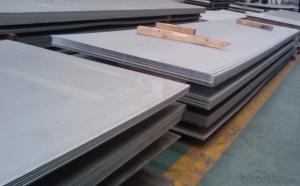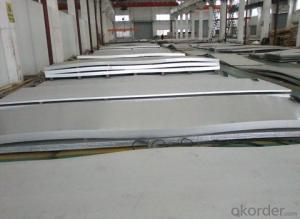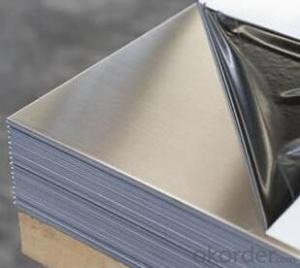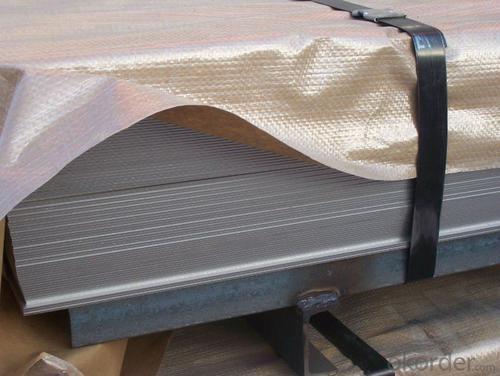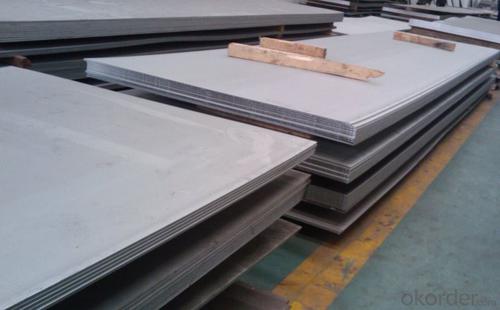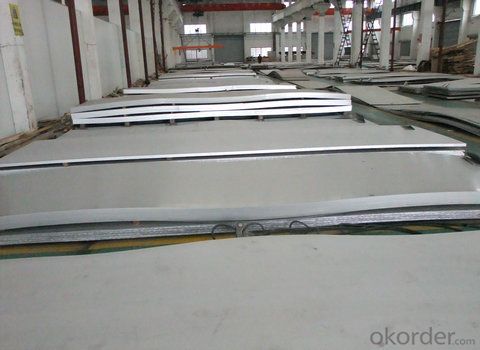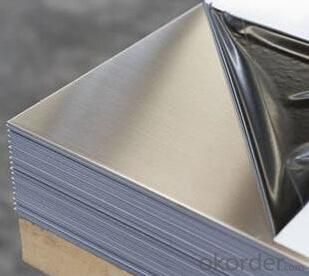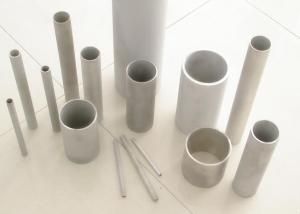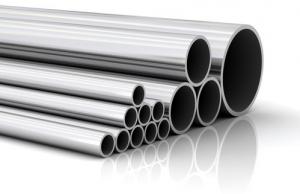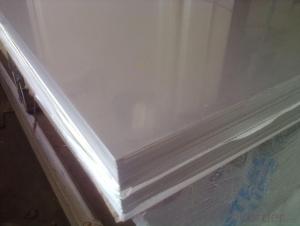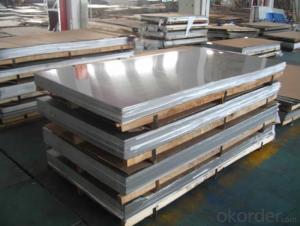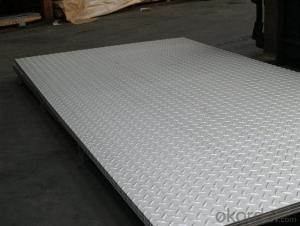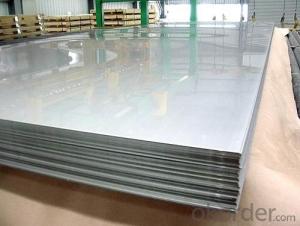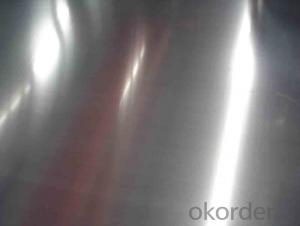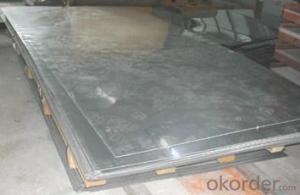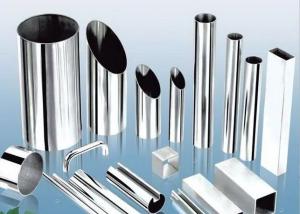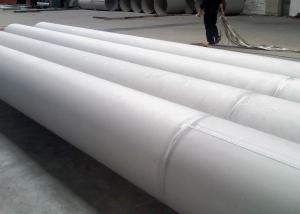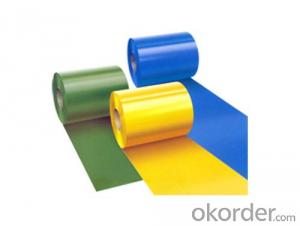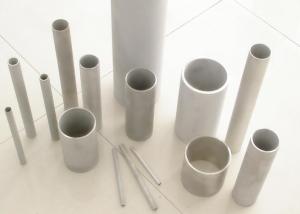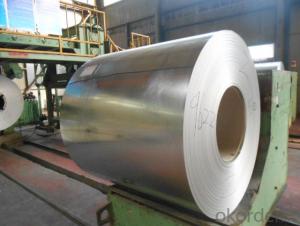Stainless Steel sheet 202 with No.4 Surface Treatment
- Loading Port:
- Shanghai
- Payment Terms:
- TT OR LC
- Min Order Qty:
- 500 m.t.
- Supply Capability:
- 5000000 m.t./month
OKorder Service Pledge
OKorder Financial Service
You Might Also Like
Hot sale stainless steel sheet 201/202/304/304l/310S/309S/316L/316Ti/316/321,410/420/430/444/443/409L, and 904L.
Description of Stainless Steel Sheet:
Description | steel sheet,hot rolled steel sheet,cold rolled steel sheet, steel sheet,sheet,steel plate |
Standard | ASME, ASTM, EN ,BS,GB,DIN, JIS etc |
Application | Steel sheet applies to construction field, ships building industry, petroleum & chemical industries, war and electricity industries, food processing and medical industry, boiler heat exchanger, machinery and hardware fields. |
Packaging | Standard export sea-worthy packing |
Delivery time | 10-30 days |
Quality | No.1 |
Productivity | 500 tons/Day |
Note | Our company has cooperative relation between the domestic agents. Stainless steel sheet can be made accordingto the customers requirements. Fasten delivery. Quality assured. |
Contacts | If you have any question,please feel free contact me. |
Stainless steel sheet surface finish characteristics
Surface finish | Characteristics and application |
2B | The surface brightness and flatness of no2B is better than no2D. then through a special surface treatment to improve its mechanical properties,No2B could nearly satisfy comprehensive uses. |
No.1 | Polished with abrasive belt of grit#100-#200, have better brightness with discontinuous coarse stria, used as inner and external ornaments for building, electrical appliances and kitchen utensils etc. |
No.4 | Polished with abrasive belt of grit #150-#180,have better brightness with discontinuous coarse stria, but thinner than No3, are used as bathtub buildings inner and external ornaments electrical appliances kitchen utensils and food processing equipment etc. |
HL | Polished with abrasive belt of grit #150-#320 on the NO.4 finish and has continuous streaks, mainly used as buildings ornaments elevators, door of building, frontal plate etc. |
BA | Cold rolled, bright annealed and skin-passed, the product have excellent brightness and good reflexivity like mirror, kitchen apparatus, ornament etc. |
8K | The product have excellent brightness and prefer reflexivity can to be the mirror. |
Main Features of stainless steel sheet :
•Escalator, Elevator, Doors
•Furniture
•Production tools, Kitchen appliances, freezers, cold rooms
•Auto Parts
•Machinery and Packaging
•Equipment and Medical devices
•Transport system
Product Details:
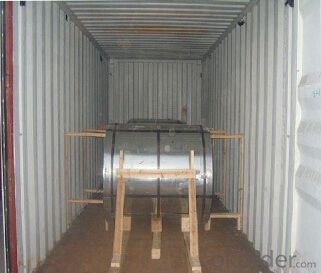
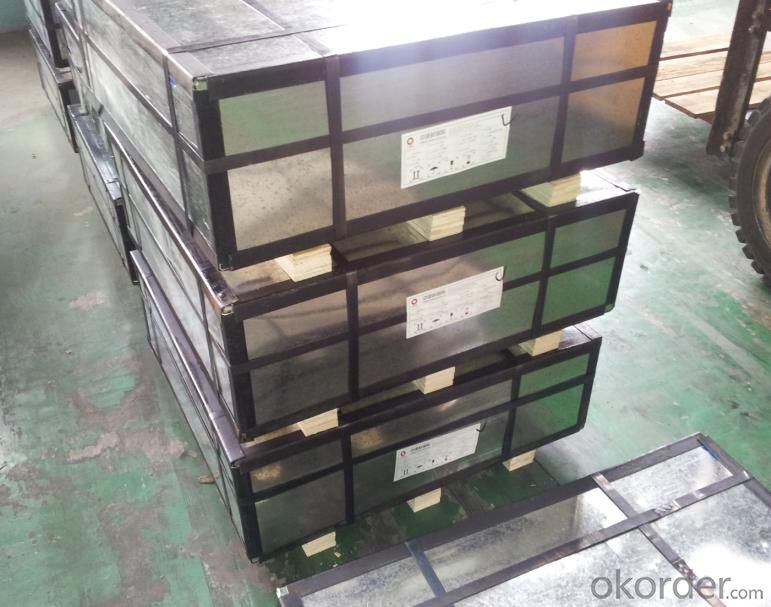
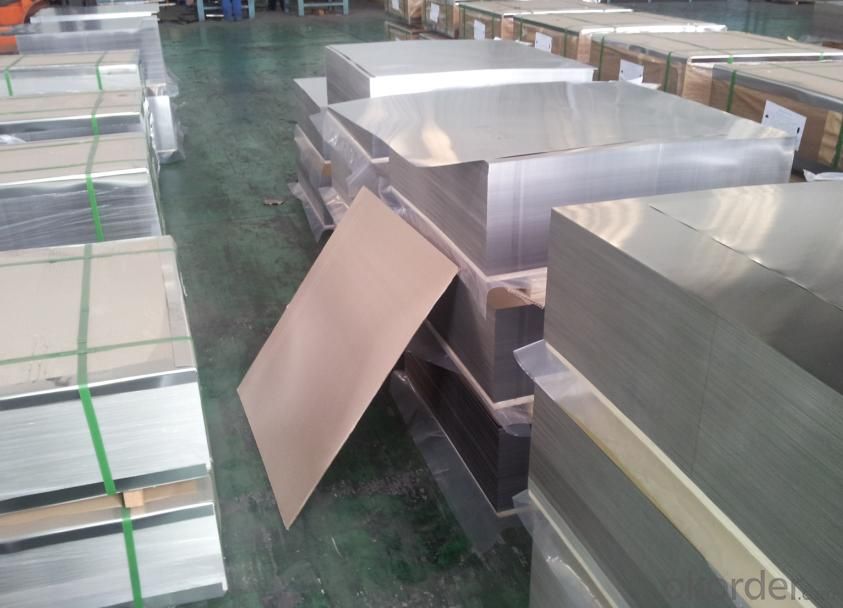
Sandard Seaworth Packing(wooden packing with water proof paper)
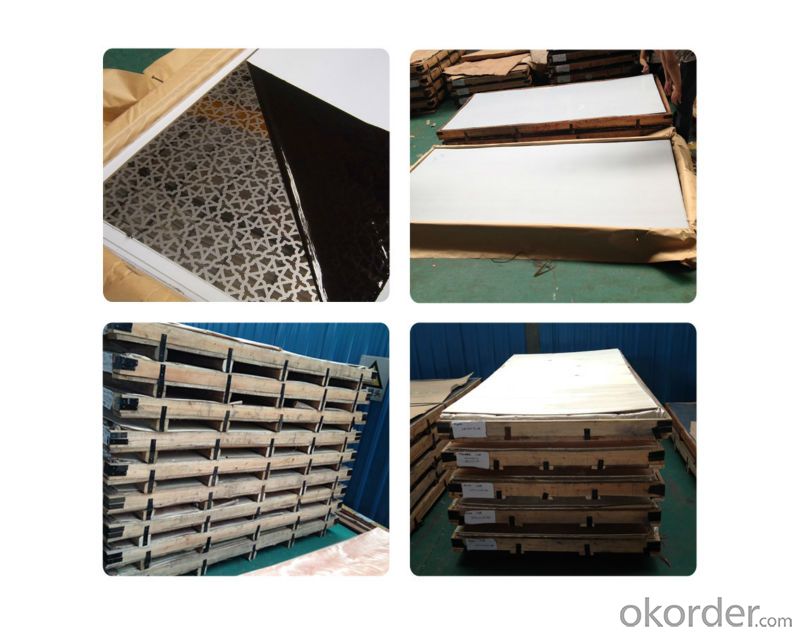
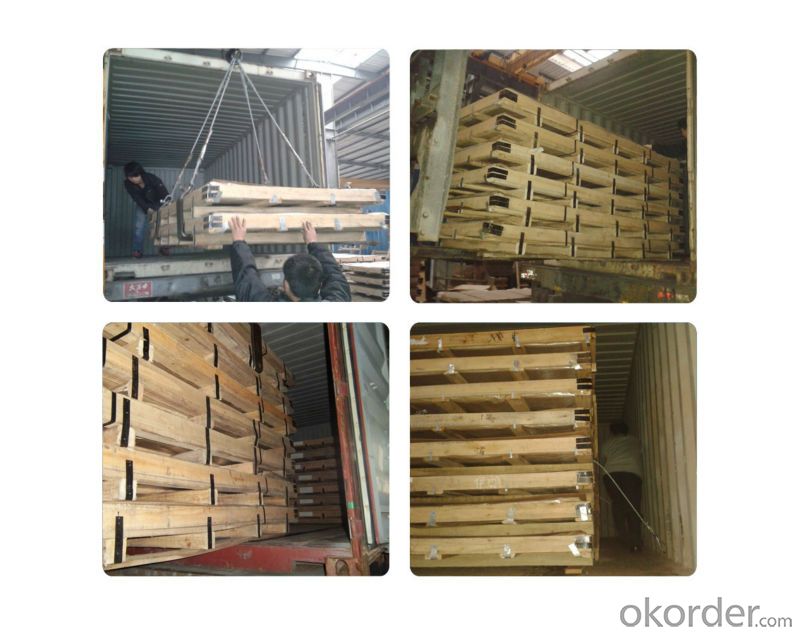
FAQ:
1. What's the quality?
very fine
2. How long get reply?
within 24 hours
If you have any question about stainless steel sheets,donot forget to sending the email to Us! You will get the competitive Price and have a very good experience about the Buying Process! CNBM International Corporation is always your trustful friend!
- Q: What are the different types of stainless steel sheet edges?
- There are three main types of stainless steel sheet edges: mill edge, slit edge, and deburred edge. 1. Mill Edge: This is the most common type of stainless steel sheet edge. It is produced during the manufacturing process and is characterized by a rough, unfinished edge. The mill edge is typically straight and perpendicular to the surface of the sheet. It is suitable for most applications where a smooth edge is not required. 2. Slit Edge: Slit edge stainless steel sheets are created by cutting large rolls of stainless steel into narrower widths. The edges of these sheets are smoother and more precise compared to the mill edge. Slit edge sheets are commonly used in applications where a more polished and precise edge is needed, such as in architectural finishes or fabrication processes. 3. Deburred Edge: A deburred edge is achieved by removing any sharp or rough edges from the stainless steel sheet. This is done to enhance safety and prevent injury during handling or installation. Deburring can be done through various methods, such as grinding, sanding, or using specialized tools. The resulting edge is smooth and free from any burrs or sharp protrusions. It is important to note that the choice of edge type depends on the specific application and requirements of the stainless steel sheet. Each edge type has its own advantages and limitations, and it is crucial to consider factors such as aesthetics, functionality, and safety when selecting the appropriate edge for a particular project.
- Q: How do you prevent distortion when welding stainless steel sheets?
- To prevent distortion when welding stainless steel sheets, one must ensure proper heat control and minimize the amount of heat input. This can be achieved by using a lower welding current and speed, employing a proper welding technique, and utilizing preheating or post-welding heat treatment methods if necessary. Additionally, using clamps or fixtures to hold the sheets in place during welding and distributing the heat evenly across the joint can also help prevent distortion.
- Q: What is the difference between stainless steel sheets and plates?
- Stainless steel sheets and plates are both types of flat metal materials that are widely used in various industries and applications. However, there are a few key differences between them. 1. Thickness: Stainless steel sheets are generally thinner than plates. Sheets typically have a thickness ranging from 0.4mm to 4mm, whereas plates are usually thicker, starting from 4mm and going up to several inches. 2. Size: Sheets are typically available in standard sizes of 4ft x 8ft or 5ft x 10ft, while plates are usually available in larger sizes and can be customized to specific dimensions. Plates are commonly used for heavy-duty applications that require greater strength and durability. 3. Weight: Due to their difference in thickness, plates are generally heavier than sheets. This makes plates more suitable for applications where weight-bearing capacity is critical, such as construction, shipbuilding, or industrial equipment. 4. Applications: Stainless steel sheets are commonly used for decorative purposes, architectural applications, and smaller-scale projects such as kitchen backsplashes or countertops. Plates, on the other hand, are preferred for structural components, machinery parts, and load-bearing applications like bridges, tanks, or pressure vessels. 5. Cost: Stainless steel plates are generally more expensive than sheets due to their larger size and higher thickness. Sheets, being thinner and smaller, are usually more cost-effective and easily accessible. In summary, the key differences between stainless steel sheets and plates are their thickness, size, weight, applications, and cost. It is important to consider these factors when choosing between the two materials for a specific project or application.
- Q: Can stainless steel sheets be used in the aerospace industry?
- Certainly, the aerospace industry can indeed employ stainless steel sheets. With its exceptional mechanical properties, corrosion resistance, and high strength-to-weight ratio, stainless steel is an incredibly versatile material. Hence, it finds great applicability in numerous aerospace uses. For instance, it is frequently utilized in fabricating aircraft elements like engine parts, structural frames, fuel tanks, and exhaust systems. Moreover, stainless steel sheets are also employed in manufacturing aerospace fittings, fasteners, and even interior cabin components. Thanks to its outstanding durability and ability to withstand extreme environments and temperature variations, stainless steel remains a dependable choice for the aerospace industry.
- Q: Can stainless steel sheets be used for roofing or cladding?
- Yes, stainless steel sheets can be used for roofing or cladding as they offer durability, corrosion resistance, and a sleek aesthetic.
- Q: Can stainless steel sheets be used for elevator handrails?
- Yes, stainless steel sheets can be used for elevator handrails. Stainless steel is a popular choice for handrails due to its durability, corrosion resistance, and aesthetic appeal. It provides a sleek and modern look, making it a suitable material for elevator handrails.
- Q: How do you prevent staining on stainless steel sheets?
- To prevent staining on stainless steel sheets, there are several measures you can take: 1. Regular cleaning: Clean the stainless steel sheets regularly using mild soap or detergent and warm water. Avoid using harsh chemicals or abrasive cleaners that can damage the surface. 2. Avoid exposure to corrosive substances: Keep stainless steel sheets away from corrosive substances such as bleach, ammonia, and acidic cleaners. If accidental spills occur, immediately rinse the affected area with water and thoroughly dry it. 3. Use a protective coating: Apply a protective coating or film on the stainless steel sheets to create a barrier between the surface and potential staining agents. There are various protective products available specifically designed for stainless steel, such as protective sprays or polishes. 4. Proper maintenance: Regularly inspect the stainless steel sheets for any signs of damage, scratches, or rust. Promptly address any issues by cleaning or repairing the affected areas to prevent staining. 5. Avoid abrasive materials: When cleaning or maintaining stainless steel sheets, use soft cloths or non-abrasive sponges to avoid scratching the surface. Avoid using steel wool or abrasive materials that can leave marks or damage the stainless steel. 6. Dry thoroughly: After cleaning the stainless steel sheets, ensure they are thoroughly dried to prevent water spots or mineral deposits from forming. Use a clean, lint-free cloth to wipe away any moisture. 7. Handle with care: Be mindful of how you handle stainless steel sheets to prevent scratching or damaging the surface. Avoid dragging or sliding heavy objects across the sheets, as this can leave marks or cause abrasions. By following these preventive measures, you can maintain the appearance and integrity of stainless steel sheets and minimize the risk of staining.
- Q: What is the minimum thickness available for stainless steel sheets?
- The minimum thickness available for stainless steel sheets can vary depending on the specific grade and manufacturing capabilities, but it is typically around 0.4 millimeters (0.0157 inches) or even thinner.
- Q: What are the different types of perforations available for stainless steel sheets?
- There are several different types of perforations available for stainless steel sheets, each serving a specific purpose and offering unique characteristics. Here are some of the most common types: 1. Round Perforations: These are the most basic and widely used type of perforations. They consist of evenly spaced round holes punched through the stainless steel sheet. Round perforations offer good airflow and visibility while providing adequate strength and durability. 2. Square Perforations: Similar to round perforations, square perforations feature evenly spaced square holes instead of round ones. Square perforations are often preferred when a more geometric and modern aesthetic is desired, as they can create a visually appealing pattern. 3. Slotted Perforations: Slotted perforations are characterized by elongated, rectangular holes that are punched through the stainless steel sheet. This type of perforation allows for better drainage and airflow, making it suitable for applications such as grilles, screens, and filters. 4. Hexagonal Perforations: Hexagonal perforations feature hexagon-shaped holes that are punched through the stainless steel sheet. This type of perforation offers an interesting visual pattern and can provide better strength and rigidity compared to round or square perforations. 5. Decorative Perforations: These perforations are specifically designed to enhance the aesthetic appeal of stainless steel sheets. They can come in various shapes, sizes, and patterns, including floral, geometric, or custom designs. Decorative perforations are often used in architectural applications, interior design, and decorative panels. 6. Micro Perforations: Micro perforations are extremely small holes that are closely spaced in the stainless steel sheet. They are commonly used in applications where a high level of precision and fine filtering is required, such as speaker grilles, ventilation systems, or sieves. It's important to note that the availability of specific perforation types may vary depending on the supplier or manufacturer. Additionally, some suppliers may offer custom perforation options to meet unique requirements or design preferences.
- Q: What's the difference between stainless steel hot rolling and cold rolling?
- Cold rolling: it is rolled and rolled on the basis of hot rolled stainless steel plate and coil. Generally speaking, it is the process of hot rolling, pickling and cold rolling. Although the rolling process also causes the steel plate to heat up during the process, it is called cold rolling. Because of the cold rolling of continuous hot rolling, the mechanical properties are poor and the hardness is too high. It must be annealed to restore its mechanical properties. Rolled rolls are generally used to make products without bending or stretching.
Send your message to us
Stainless Steel sheet 202 with No.4 Surface Treatment
- Loading Port:
- Shanghai
- Payment Terms:
- TT OR LC
- Min Order Qty:
- 500 m.t.
- Supply Capability:
- 5000000 m.t./month
OKorder Service Pledge
OKorder Financial Service
Similar products
Hot products
Hot Searches
Related keywords
